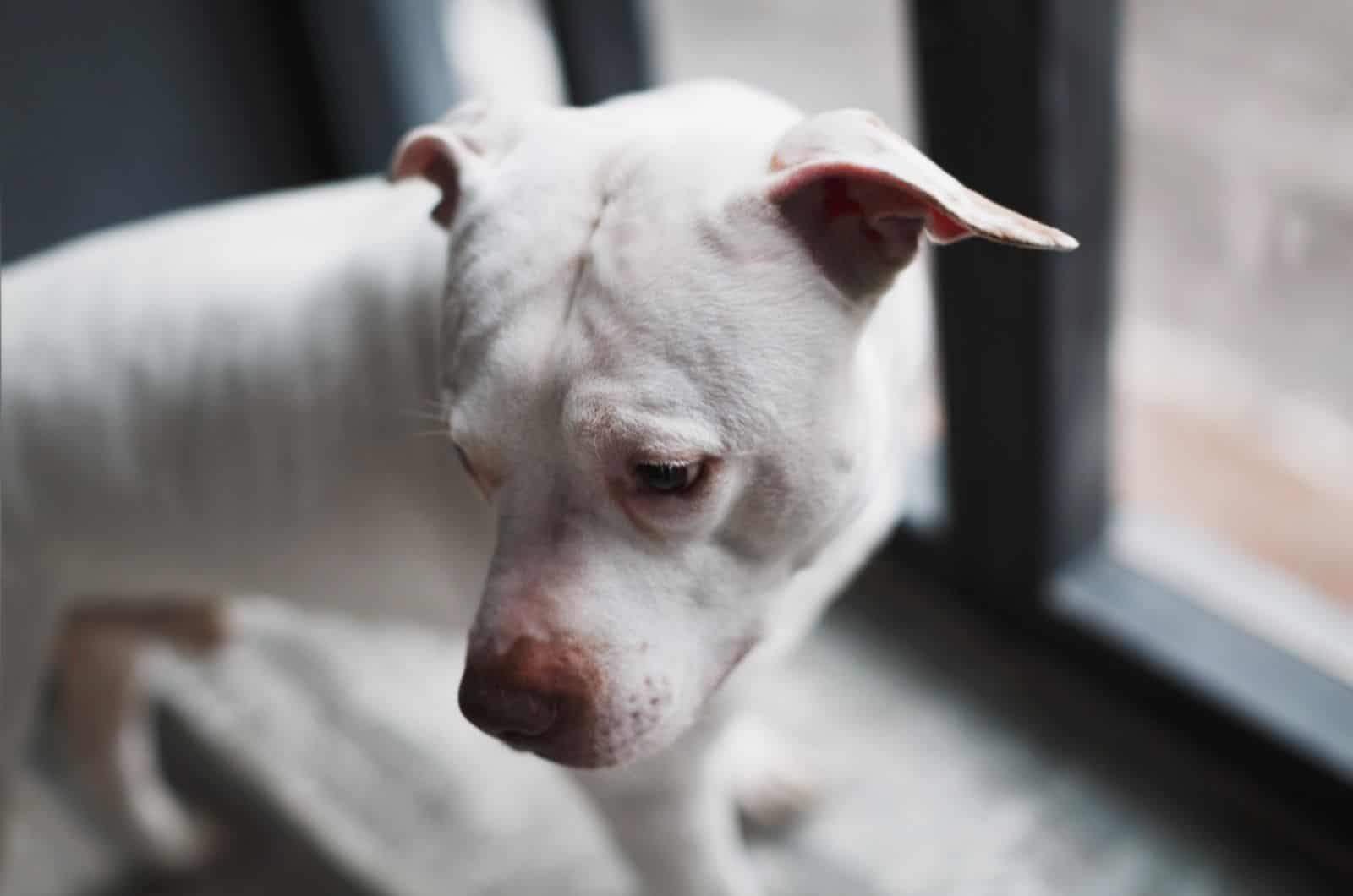How cool are Pitbulls? Very, if you ask me! These muscular athletes are nothing but sweet-hearted, loving, and affectionate human companions that crave attention. Still, we cannot talk about Pits without mentioning the Pitbull separation anxiety phenomenon first.
Sadly, separation anxiety is quite common in Pitbulls, which is why their maintenance can be pretty exhausting at times. Despite their vicious appearance and an intimidating body physique – Pit puppies are naturally dependent on their owner, and they are not at all individual-charactered.
Throughout this article, I’m going to explain the very manifestation of separation anxiety in these purebred dogs, as well as what things you can do to prevent it.
If you’re a first-time Pit owner, this is the perfect chance to get some extra info about your new dog, as well as to learn how to prevent, recognize, and act timely!
Pitbull Separation Anxiety
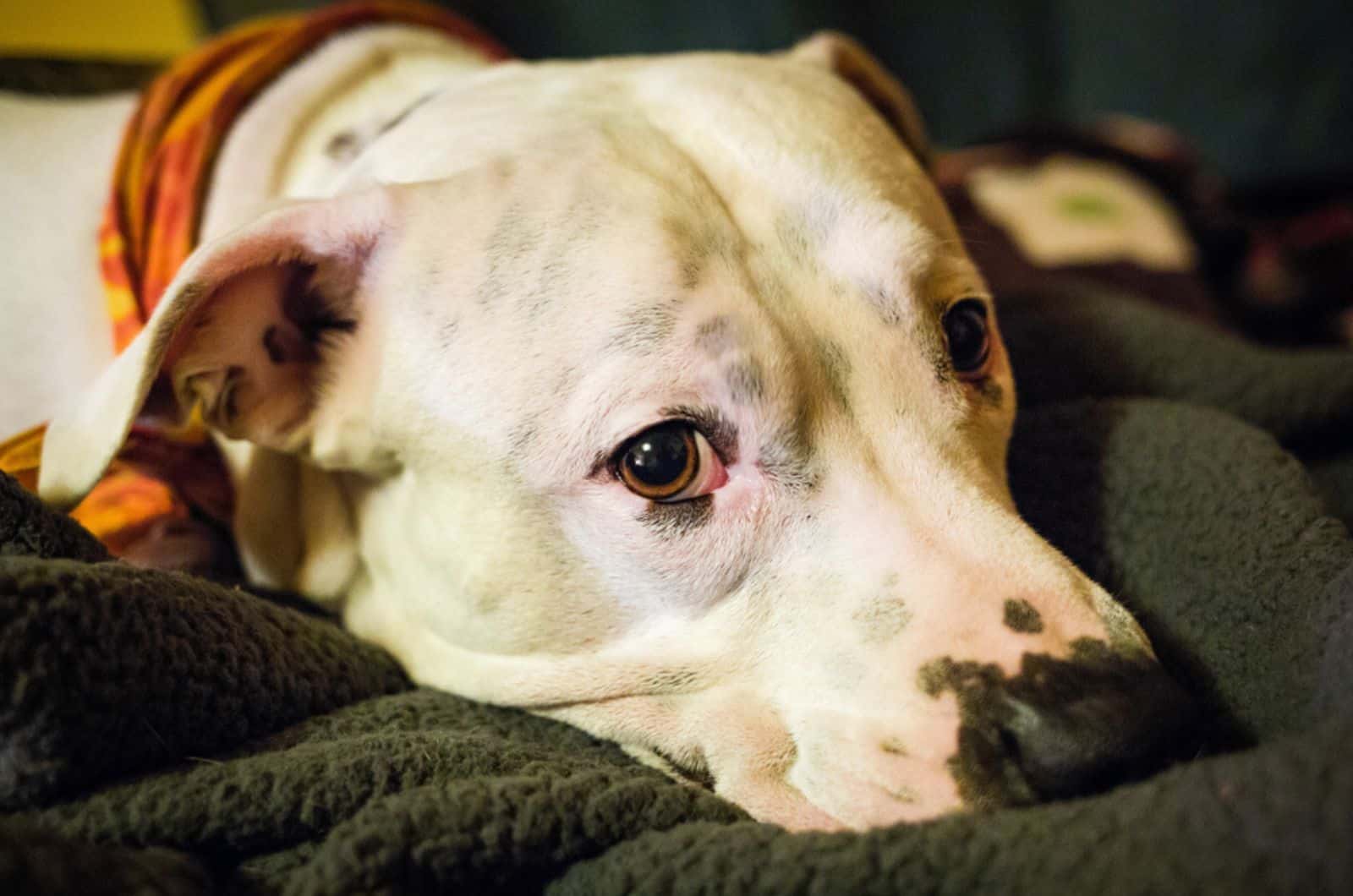
In a nutshell, separation anxiety in dogs is a phenomenon that describes the disrupted emotional state of a dog, caused by separation from its owner.
The Pitbull dog breed naturally is a highly affectionate and dependent dog that doesn’t do well in times of solitude.
Even though they have been misperceived so many times throughout history, these medium to large dogs are far from being naturally aggressive or hostile.
Instead, the Pitbull breed is rather super-dependent and loyal towards its owner, which is why it has such a hard time being separated from them even for several hours on a daily basis.
Read Next: Why Are Pitbulls So Clingy? Dealing With Needy Pitties
Being a Pit enthusiast myself, I would never recommend these canines to people with way-too-busy schedules. This breed requires a dedicated owner with a flexible work schedule.
If, however, you already have a Pit puppy in your home, but you also need to spend some hours apart from him – there are things that you can do to prevent (or to stop) its separation anxiety.
But first, let us see what the most common symptoms of separation anxiety are in these pooches.
Separation Anxiety Symptoms
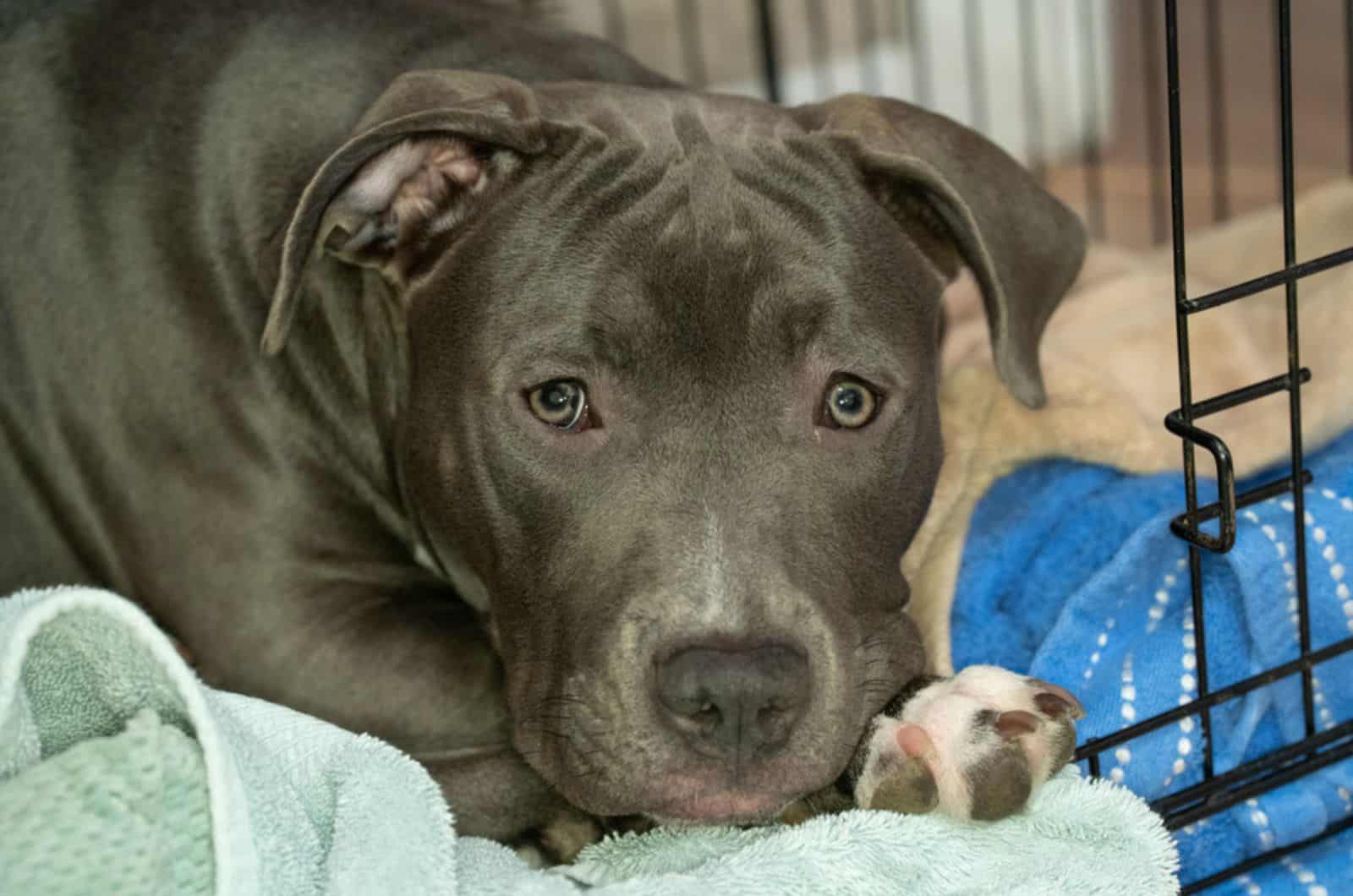
Even though there are pretty common signs of separation anxiety that even an untrained eye can notice – this phenomenon is not always on display in an obvious manner.
For example, some Pits manifest their separation anxiety by acting weird, pacing, or by a change in their routine or schedule. This may seem pretty harmless, but it can also be the sign of progressive separation anxiety.
There are, however, some pretty obvious signs that your Pitbull is suffering from separation anxiety, such as panting, urinating in weird places, hiding, aggressive behavior, and self-destructive behavior.
Panting
Panting is not only related to senior dogs. Quite the contrary – this phenomenon has a plethora of different triggers that sometimes don’t have anything to do with the physical health of your dog.
That’s the case with Pitbull separation anxiety! Panting is one of the most obvious signs of anxiety in your dog, which is why you need to react as soon as you notice it.
Even though Pits mostly pant under stress or due to a high-intensity workout, these pooches also pant when they feel anxious about something.
Unfortunately, this sort of behavior goes hand-in-hand with potential aggression and long-term trauma, which is why you need to subject your dog to treatment as soon as possible.
Minimize disturbances. Make your Pit relaxed. And, do not push it to do anything until it has calmed down. Otherwise, you’re risking your dog collapsing, even during a harmless activity.
Urinating All Over The Place
Generally, all Pitbulls are well-mannered, polite dogs that don’t display any undesirable behavior indoors. Still, some Pit puppies, due to severe separation anxiety, can urinate in odd places inside the house.
A puppy peeing a lot can sometimes be the manifestation of severe anxiety, which is why as soon as you notice this sort of behavior, you need to revisit your Pit’s schedule.
This can be an extremely frustrating and unpleasant occurrence. Anxious Pits are generally high-maintenance, especially if you are a first-time dog owner. Still, what they need instead of punishment is a soft approach and lots of love.
The problem of peeing all over the house can only be resolved by addressing the real cause of the problem. Hence, you need to find the root of your Pit peeing outside the litter box, which, most of the time, is closely related to anxiety.
Hiding
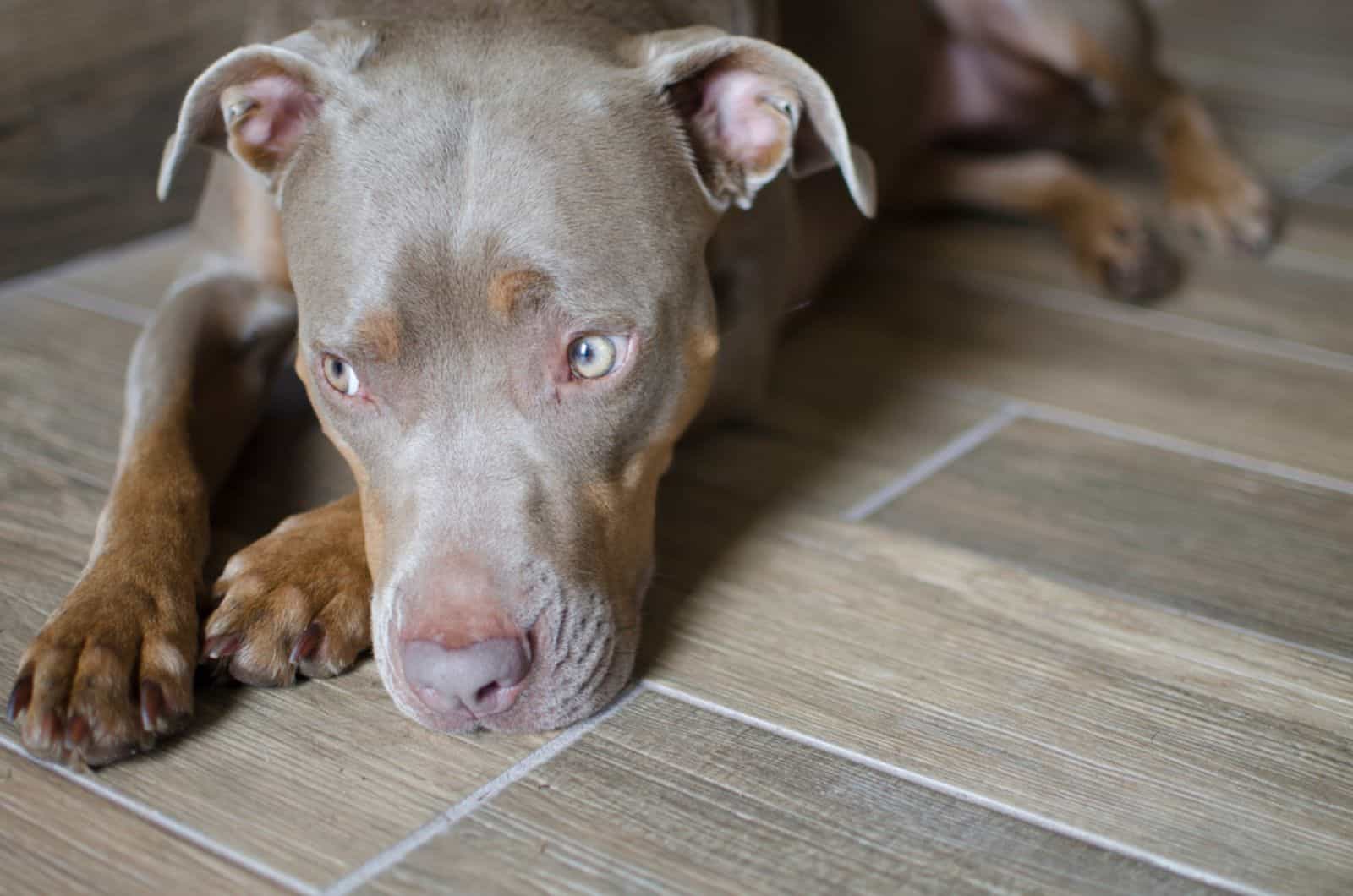
Initially, Pit canines were bred for various reasons, including guarding, companionship, protecting property, and assisting in various activities. Some Pits even make excellent babysitters.
The reason why this breed has such a broad span of purposes is definitely not because they are easily scared or intimidated.
Quite the opposite. These canines are extremely brave and fearless, which is why hiding under the bed, or in other small and dark spaces, is definitely rooted in anxiety and stress.
Pitbulls that suffered some sort of trauma are highly likely to display this sort of behavior, which is why they need to be approached carefully and slowly. Anxious and stressed Pit puppies can use aggression as a natural self-defense mechanism.
They hide because they feel insecure without their owner. Even when the owner arrives home – some Pits will remain anxious and display this unusual behavior.
Aggression And Self-Destruction
Even though they qualify among the aggressive dog breeds, these canines rarely display aggression when socialized and obedience trained. Quite the contrary – Pits are known to be one of the most tolerant dog breeds in the world.
Still, Pitbull separation anxiety can be one of the major reasons why these dogs act aggressively, even around their owner.
On the other hand, their self-destructive behavior is reflected in scratching, digging, ripping apart, chewing, or biting anything that comes their way. This sort of behavior needs to be addressed as soon as noticed, as destructive Pits can be extremely hard to live with.
Furthermore, aggressive Pit puppies should never be walked off-leash, especially in public spaces. Despite their high level of socialization and previous obedience training – anxious Pits cannot be fully trusted. That’s why they need help.
Lack Of Interest
It is no surprise to see an anxious Pitbull puppy completely lethargic and disinterested in any sort of activity.
Generally, these canines are active and playful. Their average exercise needs revolve around one to two hours on a daily basis. This implies a high-intensity workout, which is needed for their body physique to remain strong and muscular.
Still, puppies that deal with separation anxiety are highly likely to display disinterest as their primal emotion. They don’t have interest in playing, walking, interacting, or even eating.
On the other hand, they may be sleeping excessively, as well as spending most of their time laying in one place. If no physical disease is a trigger of this sort of behavior, then you should treat your Pitbull for anxiety or stress.
How To Cure Separation Anxiety In A Pitbull
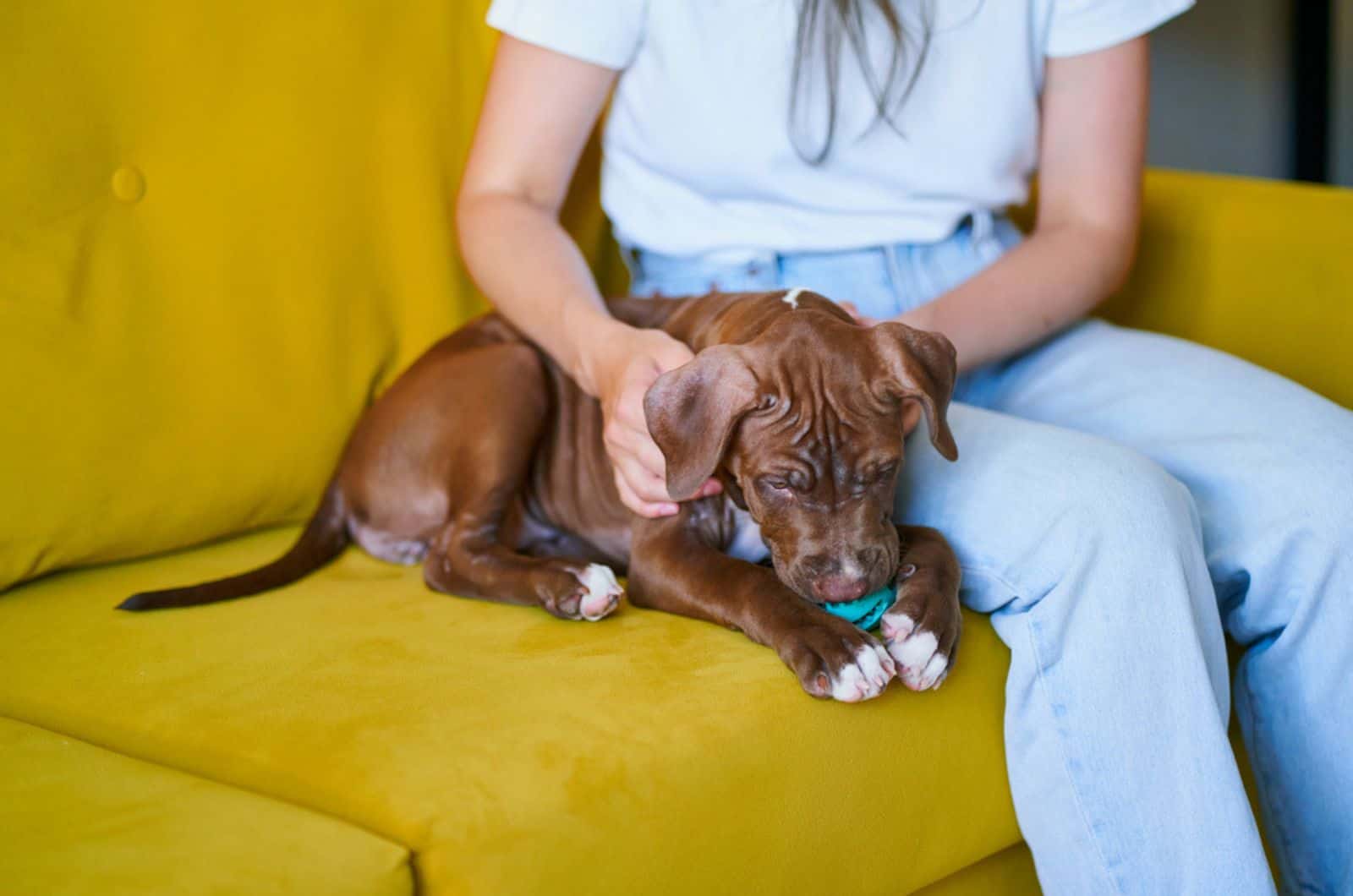
It is well-known that Pits don’t qualify among the healthiest dog breeds in the world, which is why these dogs require careful maintenance and perfect treatment by their owner. The same goes with their mental health.
These powerful pooches are not capable of spending most of their day alone, which is why they are not recommended for busy people or people who prefer “outside dogs” more.
Still, it may be possible that your PIt faces separation anxiety despite the good care that you provide. Some of these canines are so attached to their owner, even to the extent of them being miserable and frustrated by their owner going away for ten minutes or so.
If that’s the case with your puppy – here are some things that you can do to either prevent or deal with separation anxiety!
Training
Both male and female Pitbulls are known to be highly dependent on their owner. That being said, you need to train your puppy in solitude if you want to be able to leave the house without your Pit companion for a few hours on a daily basis.
Start small. Give your Pit puppy a command to sit and leave the room for a couple of minutes. Then, return to the room and don’t make a big deal out of it. This way, you will help your dog learn that it is completely normal to come and go without overwhelming goodbyes.
Exercise this several times a day. Eventually, your Pitbull will accept solitude as a natural part of its daily routine.
High-Intensity Exercise
Considering its growth chart and muscular body physique – these canines require a lot of exercise during the day. Exercise can be of huge help to adapt your Pitbull to a couple of hours of solitude. How so?
Simply, there is a positive correlation between exhaustion from a high-intensity workout and general calmness of a dog. To put it simply… dogs that exercise prior to being left alone for a specific period of time are more likely to act calmly and without separation anxiety.
Usually, Pitbulls seek a nice, comfortable place where they can rest after training. They probably won’t mind even being left alone if their nap time is on.
Interactive Toys Or TV Shows
Teaching your Pit puppy to play with interactive toys is one of the best ways to stimulate positive behavior and confidence. That being said, you should use these types of toys when training in solitude, too.
On the other hand, many experienced owners and trainers recommend occupying your dog with dog TV shows, which can be a great way to distract your dog from the fact that you are away from home. Sounds that come from a TV give your puppy a sense of security.
Getting Another Dog
This can work, but it’s also kind of risky. Getting a second dog always has to be well-prepared, planned, and thought through. Pitbull canines are not exactly the friendliest breed of dog when it comes to sharing their space with other dogs.
Still, with proper training and a slow introduction – your Pit can be a decent co-dog in your household. Getting another dog for your Pitbull will most likely boost your dog’s self-confidence, and prevent separation anxiety when you are not there.
Conclusion
Pitbull separation anxiety is quite a sensitive topic, especially if you are a first-time dog owner. This issue has to be addressed as soon as possible due to the fact that Pits aren’t exactly the friendliest and easiest dogs to live with when dealing with separation anxiety.
Hopefully, this article has given you sufficient information on how to deal with separation anxiety in your Pitbull, as well as how to properly recognize it. If, however, you’re just a Pit enthusiast, I hope that this article hasn’t discouraged you from buying one!
Read more: When To Euthanize A Sick Pitbull
